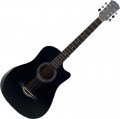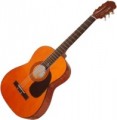Size
The overall size of the body of the guitar.
This parameter is used to select the instrument according to the personal characteristics of the musician. Even adult guitarists can vary greatly in body type, not to mention children of different ages learning to play the guitar. Accordingly, guitars for different people should have different sizes.
It is customary to indicate the size as a fraction: for example, the largest guitars are indicated as
4/4(full size). A smaller number, accordingly, denotes a smaller case, although the proportion is not strict. For example, the total length of a classical guitar (see "Type") in 4/4 is usually 1 m, and in
3/4 is 885 mm.
The smallest instruments on the market today are 1/8. They, as well as the slightly larger 1/4, are intended for children up to 6 years of age. For the age category of 6 – 9 years, the best tool is
1/2, at 9 – 11 years old — size
3/4, for teenagers and people of petite build, models 7/8 are produced, and full
4/4 are designed for boys and adults of average and large build. At the same time, all these recommendations are rather conditional, and in fact it is worth considering not only age, but also the specific specifics of each person: for example, a 4/4 guitar that has grown up quickly at the age of 13 may be quite suitable
.... It is also worth remembering that the shape of the body also significantly affects the dimensions of the guitar (see “Shape (view”)).Shape
General shape of the guitar body.
This characteristic affects both the appearance and dimensions of the instrument, as well as the characteristics of its sound. Note that for classical guitars (see “Type”) the shape is often not indicated, since it is standard for such instruments. But other varieties can be very diverse in outline. For example, among “acoustics” and “electroacoustics” there are such form options as dreadnought (western),
jumbo,
mini-jumbo, parlor, orchestral,
grand auditorium, grand concert, road, resonator. Ukuleles, in turn, are available in
soprano,
concert,
tenor,
baritone and bass versions, as well as in the form of a special variety - guitarle. Here is a more detailed description of all these types of housing:
—
Dreadnought (western). One of the most popular types of acoustic guitars. The body has a large shape and very “heavy”, angular outlines. The terms "dreadnought" and "western" are often used interchangeably, but sometimes only cutaway guitars are referred to as "westerns" (see below). This body shape provides a pronounced bass sound and a “rumbling” sound color, making dreadnoughts well suited for playing chords, but performing solos on such guitars is no
...t very convenient.
— Orchestral model. Orchestra Models are somewhat reminiscent in shape of the dreadnoughts described above, but have more rounded and graceful outlines, in particular, a more pronounced “waist” in the area of the rosette (resonator hole). This allows you to achieve an even distribution of volume between the upper and lower frequencies. In terms of application, “orchestration” is the direct opposite of westerns: they are excellent for playing by fingerpicking and note-by-note, but on chords they sound noticeably weaker - both due to the lack of bass (especially with an aggressive playing style) and due to the relatively low volume. On the other hand, thanks to the uniform frequency response, an orchestral guitar can be picked up with a regular microphone even at a professional concert.
- Jumbo. The word Jumbo means “large”, and these cases are indeed quite large in dimensions. Another distinctive feature is the shape of the lower part of the soundboard: it can be almost round, and in any case, the contours of the jumbo body are usually smoother than those of orchestral models and especially dreadnoughts (although there are exceptions). Moreover, this type of body combines the features of the mentioned varieties: a balanced and smooth sound, characteristic of “orchestration”, is combined with the volume of “Western”. Because of this, jumbo guitars are generally considered the best option for mixed-style players. However, a lot depends on the specific model: some are closer in application to dreadnoughts, and sometimes the difference between a jumbo and a western lies only in how the manufacturer positions its instrument.
- Mini jumbo. A slightly smaller version of the jumbo (see above), with correspondingly lower volume and sound richness.
- Grand Auditorium. Another versatile type of guitar. It is similar in outline to a jumbo (see above) - to the point that the terms “grand auditorium” and “jumbo” (or “mini jumbo”, depending on the dimensions) are often used interchangeably.
- Grand concert. An analogue of the Grand Auditorium described above, somewhat smaller in dimensions.
- Parlor. Cases of this type are distinguished by fairly compact dimensions - some of them are close in dimensions to a ukulele - and, most often, quite small in width, but while maintaining a full-dimensions socket. Such instruments were initially popular in the late 19th and first half of the 20th centuries; Today they are valued by professionals both for their traditional sound with “historical notes” and for their ease of transportation.
- Road. In accordance with the name, such cases are created with ease of transportation in mind. They can have either a traditional shape, close to a dreadnought or jumbo (only smaller), or very specific shapes (for example, triangular or oval, like a medieval lute).
- Resonator. Six-string guitars, also known as “Dobro” (from the name Dobro, given by the creators and later becoming a trademark). In accordance with the name, to amplify the sound, such instruments use not just a hollow body, but a special part - a resonator. This element is installed under the top deck and covered with a characteristic round metal lid with slots; the lower threshold is placed directly on the lid. “Dobro” is distinguished by a rather loud and sharp sound; In addition, some models have a special neck design that makes it easier to play using a slide. In general, such guitars have a rather narrow niche of application; they are popular primarily among blues and country/bluegrass performers.
- Soprano. The smallest type of ukulele (see “Type”), it is also historically the first and most widespread. The standard overall length of such an instrument is 21" (53 cm) with a 13" scale length (see below). Soprano models have the most high-frequency emphasis of any ukulele, and are typically tuned using GCEA (heaviest to thinnest) tuning.
- Concert. The ukulele is slightly larger in dimensions than the sopranos described above - 23" in length and 15" in scale. They provide a slightly higher volume of low frequencies, but otherwise are completely similar.
- Tenor. Further, after the concert version, the ukulele increases in dimensions - up to 26" in total length (17" in scale). In addition, they differ in tuning: they can be tuned in both GCEA and DGBE (similar to the first 4 strings of a 6-string guitar).
- Baritone. Until relatively recently (before the advent of bass-type bodies), such instruments were the largest variety of ukulele. The standard overall length for a baritone is 30", scale length is 19"; Such an instrument is usually tuned in DGBE tuning (similar to the first through fourth strings of a 6-string guitar).
- Bass. One of the newest varieties of ukulele: launched for sale only in 2007. It is almost the same in dimensions as a baritone - length is about 30", scale length is 20" - however, it uses a different tuning, namely EADG (also an analogue of a six-string guitar, in this case corresponding to strings from the fourth to the sixth).
- Gitalele. A kind of “hybrid” between a traditional guitar and a ukulele. In fact, such instruments are six-string guitars, made in the dimensions of a ukulele and tuned 2.5 tones higher - ADGCEA tuning. At the same time, the fingering, chord placement technique and tuning procedure in the guitarel do not differ from ordinary guitars. Such instruments are also called “six-string ukuleles,” but this name can also be applied to classic 4-string ukuleles, where the second and third strings are doubled. So, to avoid confusion, it is better to still use the term “gitalele”.Cutaway
Special
cutout on the body of the guitar. It is located at the base of the neck, to the right of it, if you look at the upright guitar from the front (in left-handed models — on the left). This feature makes it much easier to play on the upper frets (located near the rosette): without a cutout, the body would prevent reaching them. Therefore, this feature is highly desirable for guitarists who play notes at high frets (from the 12th and above).
There is an opinion that the cutout negatively affects the acoustics of the guitar (reduces the useful volume of the body, reduces the volume and saturation). However, in most cases, this effect is almost imperceptible, especially since manufacturers often use various tricks to compensate for this effect.
Pickguard
A special protective pad that protects the soundboard from accidental contact with the pick.
The pickguard is usually located at the sound hole below the strings (if the guitar is considered in the standard playing position). With a dynamic, aggressive performance (especially when playing chords), it is in this place that the pick clamped in the hand most often hits; hitting an unprotected body causes damage to the surface of the body, which degrades the appearance and acoustic characteristics of the guitar. Pickguard prevents such damage: such an overlay is usually made of a hard material that is resistant to contact with most picks. Accordingly, the presence of this part is highly recommended if you plan to use the pick extensively when playing.
Note that the protective overlay usually differs in colour from the main material of the deck, due to which it is clearly visible.
Number of frets
The number of frets provided on the neck of the guitar.
The fret is the gap between the two nut on the fretboard. By pressing a finger on the string in this gap, the guitarist changes the pitch of the string: the farther the fret (from the headstock) — the shorter the string is and the higher the sound.
The
more frets, the more notes the guitarist can take on each string and the more possibilities the instrument gives. On the other hand, for numerous frets, a fretboard of the appropriate length is needed, which affects the dimensions and cost of the instrument, and sometimes it is simply not justified: for example, ordinary guitars have at least
18 or
20 frets, while among ukuleles (see "Type ”), there are models for
12 – 16 frets.
In general, it makes sense to specifically look for an instrument with numerous frets if you plan to play complex solo parts on it; for playing chords, as well as relatively simple performance by notes, the number of frets does not play a special role.
Neck material
The material from which the neck of the guitar is made — more precisely, the base of the neck (the fretboard can be made from another material). Now the most commonly used materials are:
nato,
maple and
mahogany. For the value of this parameter, see p. "Top deck".
Fretboard
The fingerboard material is the surface directly under the strings. Now the most commonly used materials are:
rosewood,
mongoy and
ebony. For the value of this parameter, see p. "Top deck".

